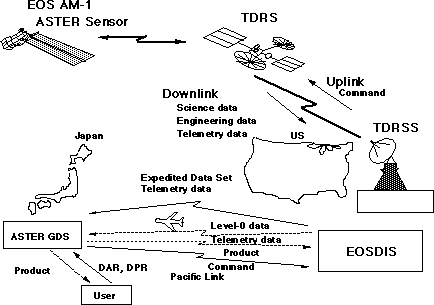
|
 |
 |
Observation Modes |
|
ASTER operates, for the basics, in FULL mode (operating in all bands) for daytime and TIR mode (with only TIR operating) for nighttime; and the other observation modes are: VNIR Only mode, TIR Only mode and STEREO mode (Nadir + Backwards ; both in band 3) for daytime, and SWIR+TIR mode (for objects with a high temperature such as lava) for nighttime. The mode shifts are contingent on data acquisition requests from the user community.
|
 |
ASTER observation modes (** STEREO mode) |
|
|
Mission Mode |
Sub-System |
Data Rate |
| VNIR |
SWIR |
TIR |
| Day |
Full Mode
VNIR Mode
TIR Mode
Stereo Mode |
**
**
** |
* |
*
*
|
89.2 Mbps
62.038 Mbps
4.109 Mbps
31.019 Mbps |
| Night |
TIR Mode
SWIR+TIR Mode |
|
* |
*
* |
4.109 Mbps
27.162 Mbps |
|
|
|
Because ASTER is a state-of-the-art imagery with high spatial resolution, the data rate is so gigantic as to reach 89.2Mbps. Given 8.3Mbps for two orbits earmarked for ASTER of average maximum data rate, the maximum operational time per orbit comes to 8 minutes each for daytime (given in FULL mode) and night time (given in TIR mode). This is where daily mission planning matters; it is required to make daily mission schedule in optimal way.
In FULL mode, ASTER collects up to 780 scenes of daytime data in one day.
|
 |
Observation scenario
|
|
ASTER observation is contingent on the requests from ASTER Science Team, AO researchers, or other authorized users and institutions that ASTER acquire new data. With consideration given to user category, data usage, etc., three options are set for request submission as categorized below:
1) DAR (Data Acquisition Request)
to observe a local area, submitted by the users registered on ASTER GDS, such as a member of ASTER Science Team and an AO researcher,
2) STAR (Science Team Acquisition Request)
to monitor a regional area (and perhaps a local area as well) or to obtain data in a time sequence - essential to pass through authorization process by ASTER Science Team,
3) ETR (Engineering Team Request)
to obtain engineering data that are necessary to maintain ASTER instruments in a proper status
A user should submit his/her observation request by 36 hours before the observation (TBR). In case of contingency such as natural hazards, however, such requests may be accepted as "urgent" data request after the evaluation for its emergency, significance, influence on other observation schemes, and others.
Illustrated below is the data flow between Japan and the U.S.A
|
 |
Aster Data Flow
|
|
* Just click for larger figure.
 |
|
 |
|




